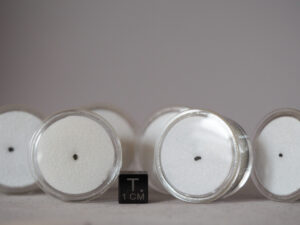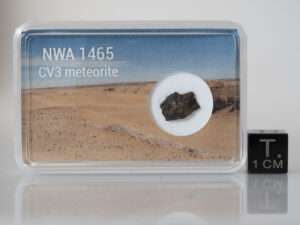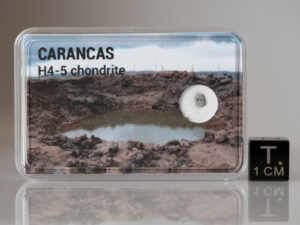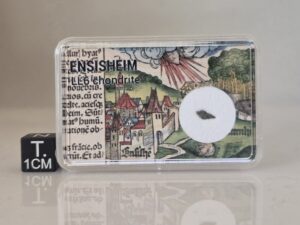Description
Fragment sold with label / certificate of authenticity and L. Labenne label copy. provenance (2.9g lot of fragments) : IPGP > L. Labenne
In 1492, a meteorite fell into a field on the edge of a nearby forest from the Alsatian town of Ensisheim. Alone a young boy witnesses the fall in a wheat field, at a place called Les Grands Laubourg, south of the city. There stone lies in a hole one meter high depth. After the residents and the Council of the city had been warned, everyone go on site; the meteorite has already been damaged, everyone wishing keep a fragment of it. The board takes strict measures to stop this massacre and bring the stone in the church of Ensisheim where many curious people can come admire this celestial present. Twenty days later, King Maximilian of Austria, in conflict with the king of France Charles VIII, goes to his lands Alsatians and hears about the rock. He detaches two fragments of the main mass, canned one then give the other to the Archduke Sigismund of Austria. The meteorite
is then hung in the church; an old inscription attached to it indicates: “De hoc lapide multi multa, omnes aliquid, nema satis » (“Many have spoken of this stone, everyone said something, no one hasn’t said enough.” Sébastien Brant (1458-1521), professor of literature Latin and law at the University of Basel, precursor of Alsatian humanism, writes “loose sheets relating to the Thunder Stone” which are neither more nor less than political texts in favor of King Maximilian of Austria; Brant skillfully turns the texts into considering that the object coming from the sky can only be a divine sign, the sign that Maximilian must fight the French and that he will win definitely war.
Like many other goods belonging to the Church, the meteorite is won by the Revolutionaries then is transported to the Colmar museum in 1795 where it is stored without attention private for ten years; in 1804, the stone, which now weighs only 55 kg, returns to Ensisheim and finds his place, suspended in the choir of the church.
The building, which was no longer maintained since the French Revolution, is in very poor condition. Indeed, the November 6, 1854, the bell tower collapsed. Rescued, the meteorite is stored first in the school then in the Ensisheim town hall. This is how it is in the Palais de la Régence, where was located the old town hall, that meteorite is preserved and, nowadays, put on display in the Museum.








